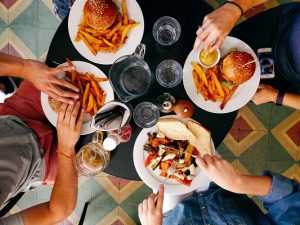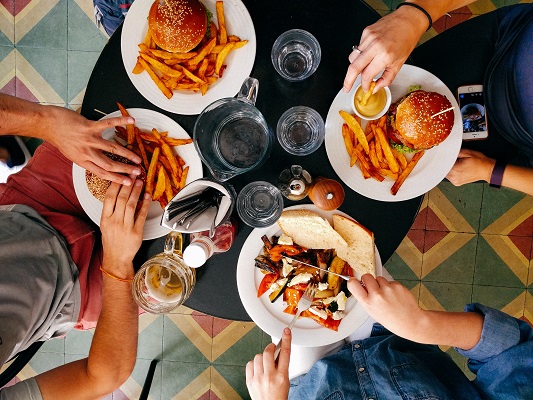
Image Credit: Photo by Dan Gold on Unsplash
So it turns out that restaurants have CIOs also. These CIOs are tasked with the challenge of understanding the importance of information technology and finding ways to use IT resources to make the restaurants that they work for even better than they already are. In order to make this happen, restaurants are going to have to collect a great deal of data about their customers and then use big data techniques to turn that data into knowledge that the restaurant can take action on.
Collecting The Data
So how is the person with the CIO job going to go about collecting the customer data that they are going to need? One way is by using the restaurant’s mobile application. If they can set it up correctly, then when a customer places an order using the mobile application the restaurant can ask them to select from a list of potential dietary restrictions. Once the customer has made their selections, any items on the menu that use forbidden ingredients can be flagged with a red asterisk so that customers know to avoid them. Once entered, the customer’s selections can be saved to be used the next time that they place an order.
The person in the CIO position knows that data is now starting to show up as a powerful weapon that restaurants can use as they battle for customers. Since there are now more restaurants to choose from and the menus for each of these restaurants has become larger, customers now have more choices than ever before. Restaurant CIOs believe that by using customer data to find ways to tailor menus to customer tastes can potentially provide their restaurant with a leg up on the competition.
So what has changed? In the past, the mom & pop restaurants knew their customers and were able to tailor their offerings to them. Likewise, the fine-dining establishments did the same. However, the arrival of mobile age has changed things for all restaurants. Restaurants can now use mobile apps and digital reservation systems to better track both customer preferences and spending habits. Once the restaurants have this information, they can then share it across their systems. In the past year, 2.8 billion restaurant orders were placed digitally. This is 5% of the total orders which is up from 2% just three years ago.
Using The Data
Today a lot of restaurants collect data on their customers through their loyalty programs. However, CIOs understand that the problem with such data is that it is only providing them with data on their most loyal customers. These are not the customers that the restaurant really needs to find a way to convince to return to the restaurant. If a restaurant collects a customer’s email address without taking the time to understand what they are actually ordering then they will have a problem. They will only be able to send out promotional emails to everyone on their list without being able to target people who purchase specific types of food.
A much better way to use data that has been collected is to first collect it when a customer places an order using their mobile app. Starbucks originally only permitted people who were members of their Starbucks Rewards loyalty program to place orders using their mobile app. When they realized that there were another 60M customers that they really did not know anything about, they opened up the app to everyone to use. Starbucks has also started to require customers using their free instore WiFi service to register using their email address. This has provided them with data on an additional 5M customers.
CIOs understand that their next challenge is going to be to provide their customers with even more personalized services. Once they have the information needed to do this, they’ll be able to share it across their chain or company. Restaurants are learning that they can use the knowledge that they have collected about their customers in order to both improve service and better target their guests with promotional events such as wine tastings. The customer information is also being made available to servers who will then use it in order to steer guests to try new dishes.
CIOs hope that by using customer information to provide more customized service they will be able to generate higher guest satisfaction and have customers have more repeat visits to their locations. Restaurant managers can review a customer’s past ordering history and use it to greet them with a cocktail that they have enjoyed in the past. CIOs understand that it is the little things that matter the most. When a guest always orders the same dish, a manager may send them a new dish “on the house”. The goal is to expand their horizon and make it more likely that they will return. CIOs believe that the challenge for any personalized dining experience is how you can create a sense of discovery. The data that they are collecting about their customers provides them with a huge opportunity to do that in food.
What All Of This Means For You
Restaurants have CIOs and those CIOs have a goal: use IT to find ways to attract more customers to come and dine at their restaurants. In order to do this successfully, CIOs understand that they need to better understand their customers. In order to make this happen, CIOs have to collect as much data on their customers as they possibly can. Once they have the data, big data techniques need to be used to transform that data into knowledge that can be put to use in the individual restaurants.
In order to better understand their customers, CIOs need customer data. In order to get it they can collect data from their customers when they place orders using mobile apps. Customers can also indicate if they have any dietary restrictions that can be used to help them to make food selections. Restaurant CIOs are starting to understand that customer data is a weapon that they can use in order to do battle with other restaurants. The arrival of mobile ordering apps has provided restaurant CIOs with a great deal of customer data. Restaurants can now use mobile apps and digital reservation systems to better track both customer preferences and spending habits. The goal of any restaurant is to convince a customer to return again in the future. CIOs want to use customer data to provide more personalized service to their customers. CIOs hope to use personalized customer data to provide a better dining experience for their customers so that they will return more often.
The key to attracting and retaining more customers is customer data. The arrival of mobile ordering and reservation applications has suddenly provided restaurant CIOs with more data then they have ever had before. What they now need to do is to find ways to use big data mining techniques to shift through all of the data that they have and find ways to extract the personalized customer information that will be required in order to get customers to keep coming back to their restaurants.
– Dr. Jim Anderson
Blue Elephant Consulting –
Your Source For Real World IT Department Leadership Skills™
Question For You: Do you think that it is possible for a CIO to go too far with how much data that they can collect about a single customer?
What We’ll Be Talking About Next Time
One does not often think about farming and CIOs in the same thought. However, it turns out that the way that food is being grown and harvested is in the process of undergoing a radical transformation. Technology is being applied to the fields where our food is grown and how best to apply that technology is something that CIOs are being asked to determine. What this means for the average CIO is that they’ve got some learning to do about how food gets from the field to our tables.

